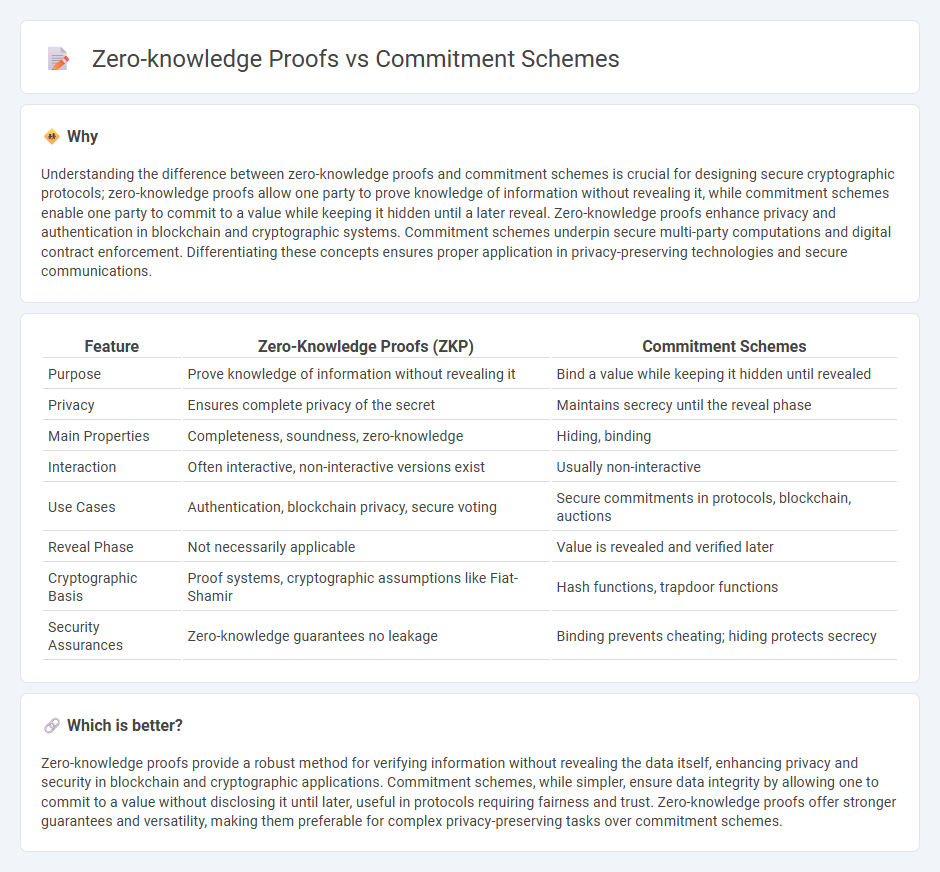
Zero-knowledge proofs enable one party to prove knowledge of a secret without revealing the secret itself, ensuring privacy and security in cryptographic protocols. Commitment schemes allow a party to commit to a chosen value while keeping it hidden, with the ability to reveal it later, serving as a foundation for secure multi-party computations. Discover how these advanced cryptographic techniques enhance data integrity and confidentiality.
Why it is important
Understanding the difference between zero-knowledge proofs and commitment schemes is crucial for designing secure cryptographic protocols; zero-knowledge proofs allow one party to prove knowledge of information without revealing it, while commitment schemes enable one party to commit to a value while keeping it hidden until a later reveal. Zero-knowledge proofs enhance privacy and authentication in blockchain and cryptographic systems. Commitment schemes underpin secure multi-party computations and digital contract enforcement. Differentiating these concepts ensures proper application in privacy-preserving technologies and secure communications.
Comparison Table
| Feature | Zero-Knowledge Proofs (ZKP) | Commitment Schemes |
|---|---|---|
| Purpose | Prove knowledge of information without revealing it | Bind a value while keeping it hidden until revealed |
| Privacy | Ensures complete privacy of the secret | Maintains secrecy until the reveal phase |
| Main Properties | Completeness, soundness, zero-knowledge | Hiding, binding |
| Interaction | Often interactive, non-interactive versions exist | Usually non-interactive |
| Use Cases | Authentication, blockchain privacy, secure voting | Secure commitments in protocols, blockchain, auctions |
| Reveal Phase | Not necessarily applicable | Value is revealed and verified later |
| Cryptographic Basis | Proof systems, cryptographic assumptions like Fiat-Shamir | Hash functions, trapdoor functions |
| Security Assurances | Zero-knowledge guarantees no leakage | Binding prevents cheating; hiding protects secrecy |
Which is better?
Zero-knowledge proofs provide a robust method for verifying information without revealing the data itself, enhancing privacy and security in blockchain and cryptographic applications. Commitment schemes, while simpler, ensure data integrity by allowing one to commit to a value without disclosing it until later, useful in protocols requiring fairness and trust. Zero-knowledge proofs offer stronger guarantees and versatility, making them preferable for complex privacy-preserving tasks over commitment schemes.
Connection
Zero-knowledge proofs and commitment schemes are cryptographic protocols that enhance data security and privacy by enabling one party to prove knowledge of a secret without revealing the secret itself. Commitment schemes function as a preliminary step in zero-knowledge proofs, allowing a prover to commit to a value while keeping it hidden, ensuring the value cannot be changed later. This connection is crucial in applications like blockchain, secure voting, and identity verification, where trust and confidentiality are paramount.
Key Terms
Hiding vs. Zero-Knowledge
Commitment schemes emphasize the property of hiding, ensuring that a committed value remains secret until revealed, while zero-knowledge proofs focus on zero-knowledge, allowing one party to prove knowledge of a fact without revealing the fact itself. Commitment schemes are foundational for protocols requiring data binding and secrecy, whereas zero-knowledge proofs provide strong privacy guarantees in verification processes. Explore how these cryptographic tools differ and complement each other for secure communications.
Binding vs. Soundness
Commitment schemes ensure binding by preventing the committer from changing the committed value after the commitment phase, securing data integrity in cryptographic protocols. Zero-knowledge proofs emphasize soundness, guaranteeing that no fraudulent prover can convince the verifier of a false statement while preserving privacy. Explore the distinctions between binding in commitment schemes and soundness in zero-knowledge proofs to deepen your understanding of cryptographic security mechanisms.
Reveal (Opening) vs. Verification
Commitment schemes involve a two-phase process where the sender first commits to a value and later reveals (opens) it to prove authenticity without altering the original commitment. Zero-knowledge proofs focus on verification, allowing a prover to convince a verifier of the truth of a statement without revealing the underlying secret, maintaining privacy throughout the interaction. Explore how these cryptographic tools differ in balancing data integrity and privacy by learning more about their reveal and verification mechanisms.
Source and External Links
Commitment scheme - Wikipedia - A commitment scheme is a cryptographic primitive allowing one to commit to a secret value while keeping it hidden, with the ability to reveal it later; it has a commit phase (hiding the value) and a reveal phase (disclosing it) and ensures the value can't be changed after commitment (binding).
Commitment Schemes - UCSD Lecture Notes - These schemes enable a sender to commit to a message using a random key and randomness during the commit phase, sending a commitment to the receiver, who later verifies the message authenticity upon reveal.
Commitment Schemes - zkDocs - Commitment schemes, introduced by Blum in 1981, solve problems like fair coin flipping by phone, allowing one party to commit a choice secretly and reveal it later, ensuring fairness and immutability.
 dowidth.com
dowidth.com